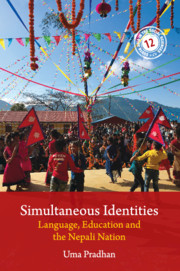Book contents
- Frontmatter
- Contents
- List of Figures
- List of Tables
- List of Appendices
- List of Abbreviations
- Acknowledgements
- Notes on the Use of Terms, Transliteration and Names
- Introduction: Language, Education and the Nepali Nation 1
- 1 Language, Education and State-Making in Nepal
- 2 Mother Tongue and the Construction of an Educated Person
- 3 Language, Public Space and Identity
- 4 Transforming Language to a Script
- 5 Language, Education and Knowledge-Making
- 6 Quality, Equality and Language Ideology
- 7 Ethnicity, Education and Employment
- Conclusion: Simultaneous Identities
- Appendices
- Glossary
- Bibliography
- Index
1 - Language, Education and State-Making in Nepal
Published online by Cambridge University Press: 30 April 2020
- Frontmatter
- Contents
- List of Figures
- List of Tables
- List of Appendices
- List of Abbreviations
- Acknowledgements
- Notes on the Use of Terms, Transliteration and Names
- Introduction: Language, Education and the Nepali Nation 1
- 1 Language, Education and State-Making in Nepal
- 2 Mother Tongue and the Construction of an Educated Person
- 3 Language, Public Space and Identity
- 4 Transforming Language to a Script
- 5 Language, Education and Knowledge-Making
- 6 Quality, Equality and Language Ideology
- 7 Ethnicity, Education and Employment
- Conclusion: Simultaneous Identities
- Appendices
- Glossary
- Bibliography
- Index
Summary
Local dialects and tongues other than standard Nepali, should be banished from the school and playground as early as possible in the life of a child.… The study of a non-Nepali local tongue would mitigate against the effective development of Nepali, for the student would make greater use of it than Nepali, at home and in the community, and thus Nepali would remain a ‘foreign’ language. If the younger generation is taught to use Nepali as the basic language, then other languages will gradually disappear and greater national strength and unity will result.
—National Educational Planning Commission Report, 1956, pp. 96–97All the languages spoken as the mother tongue in the various parts of Nepal are the national languages of Nepal (Article 6.2). Each community shall have the right to operate schools up to the primary level in its own mother tongue for imparting education to its children.
—Constitution of Nepal, 1990, Article 18.2Every Nepali community living in Nepal shall have the right to acquire education in its mother tongue up to the secondary level, and the right to open and run schools and educational institutions as provided for by law.
—Constitution of Nepal, 2015, Article, 31.5Nepal is a country with a population of approximately 29 million. However, it is extremely diverse. According to the census of 2011, there are 125 ethnic groups and 123 languages spoken in Nepal. This diversity in its population, and the varied response of Nepali state to this heterogeneity, has significantly shaped much of the intergroup and intragroup relations in Nepal. As one of the prominent scholars (Malla, 1979: 135) points out, Nepal cannot be understood through the lens of neat segmentation of people into ‘two languages, two peoples, or even two cultures – the language of conquerors, i.e. the Gorkhas, and the language of the subjugated people. Such segmentation is not very helpful for examining the complex ethnic, cultural, and linguistic situation in Nepal.’
This chapter is a historical account on the process and nature of institutionalisation of various languages in Nepal. First, I trace its historical development and situate the discussion on the changing politics of contemporary Nepal.
- Type
- Chapter
- Information
- Simultaneous IdentitiesLanguage, Education, and the Nepali Nation, pp. 31 - 66Publisher: Cambridge University PressPrint publication year: 2020



